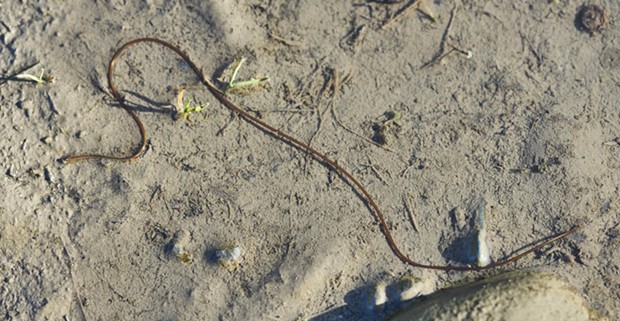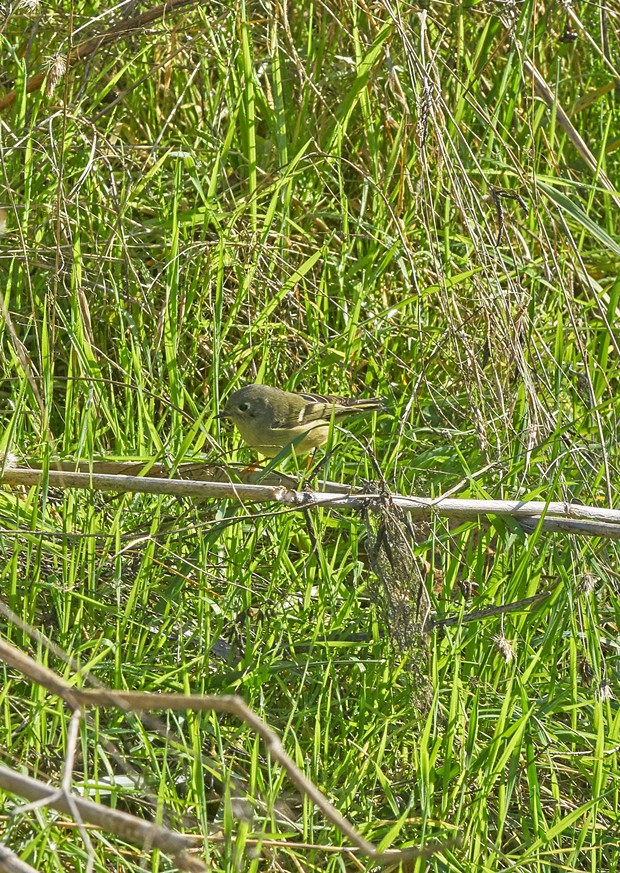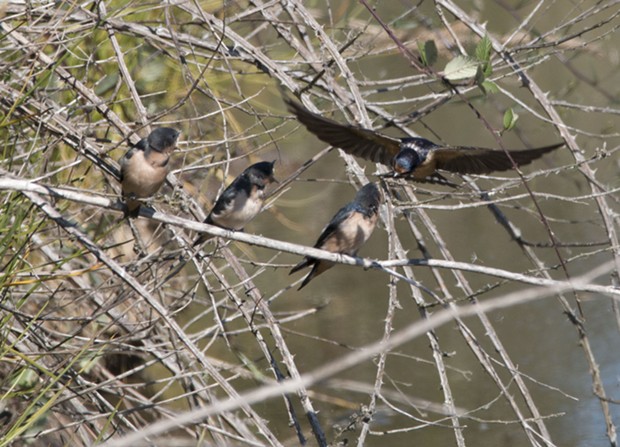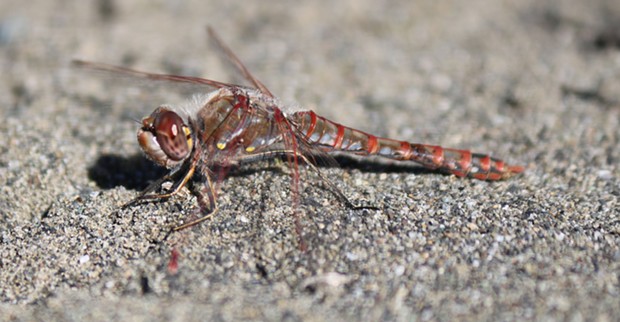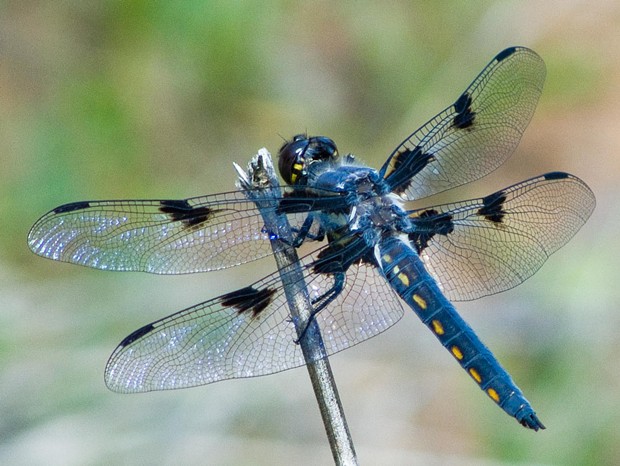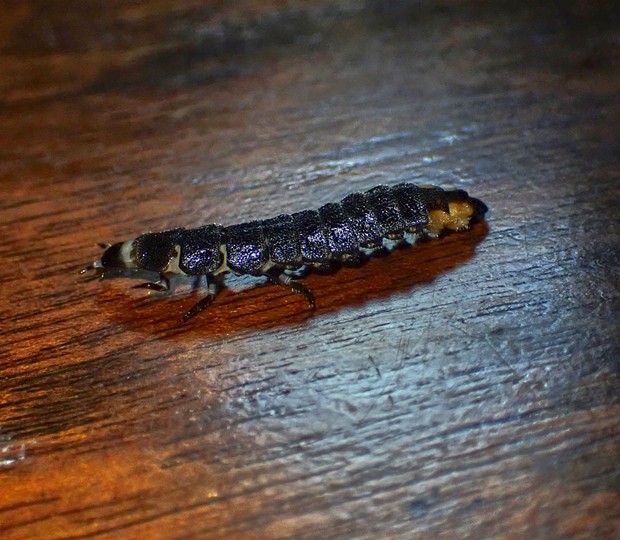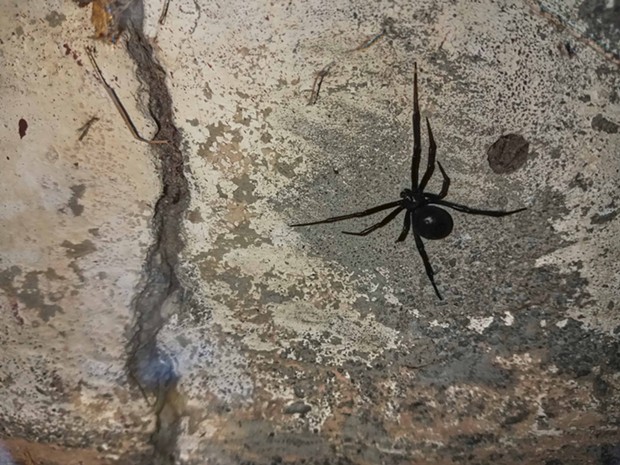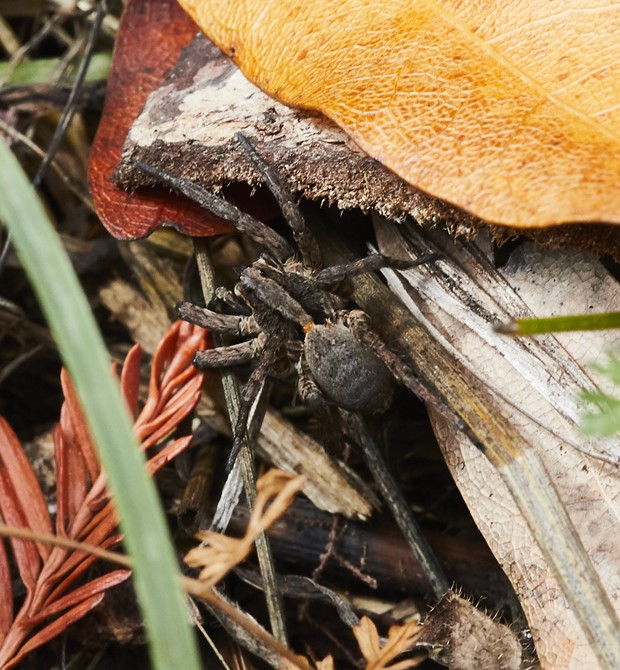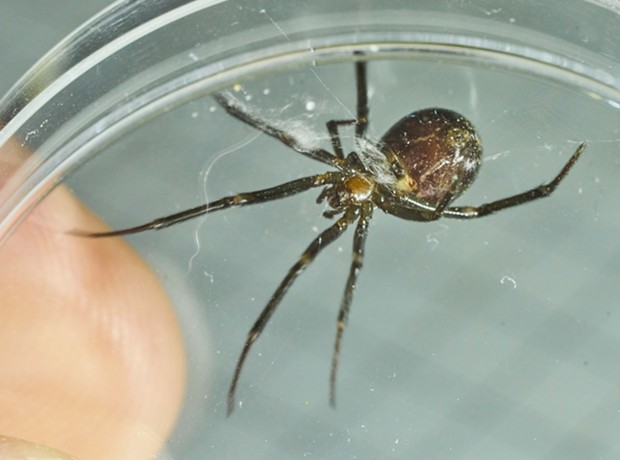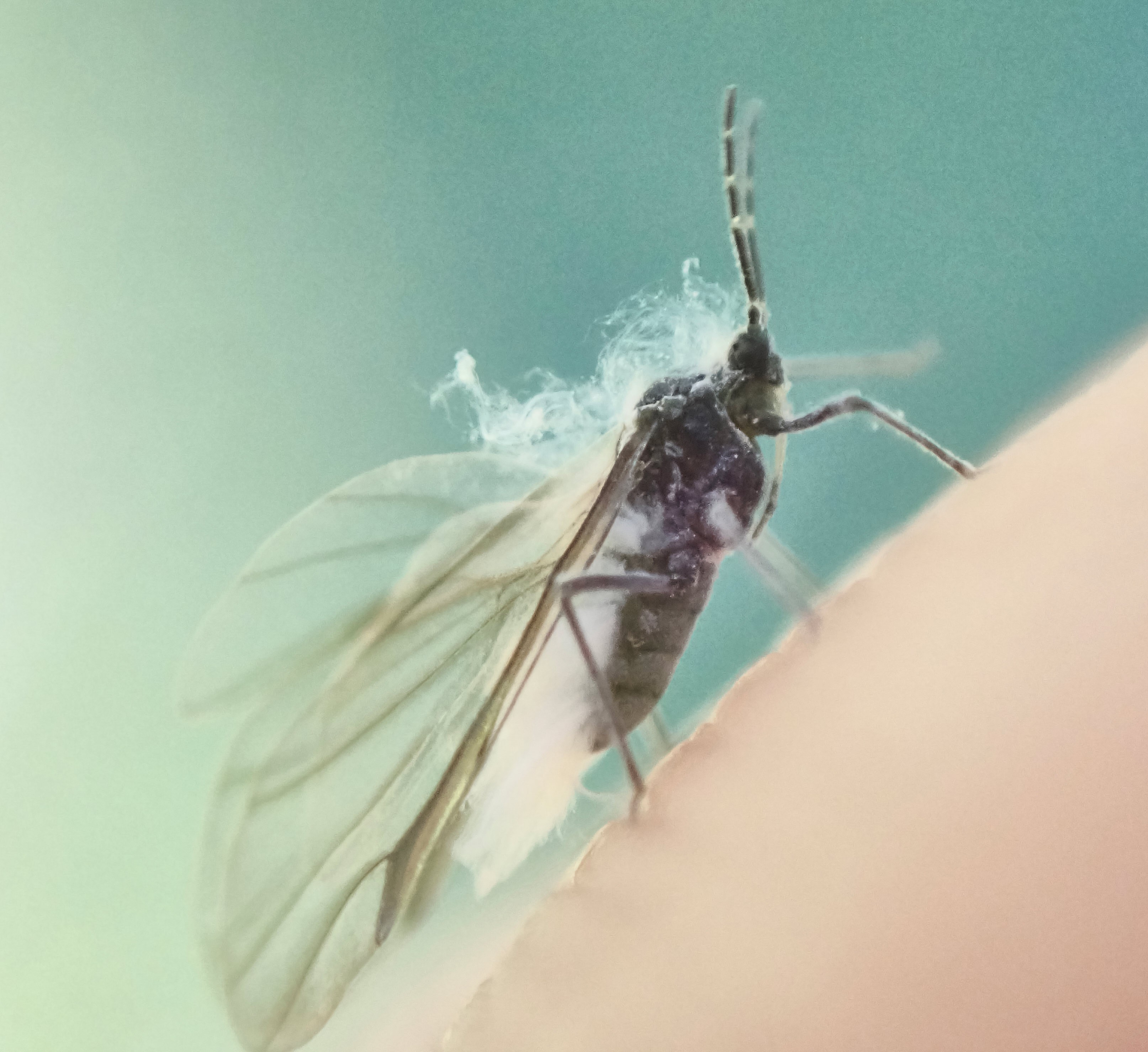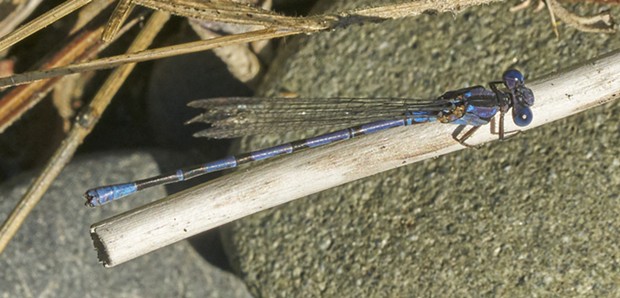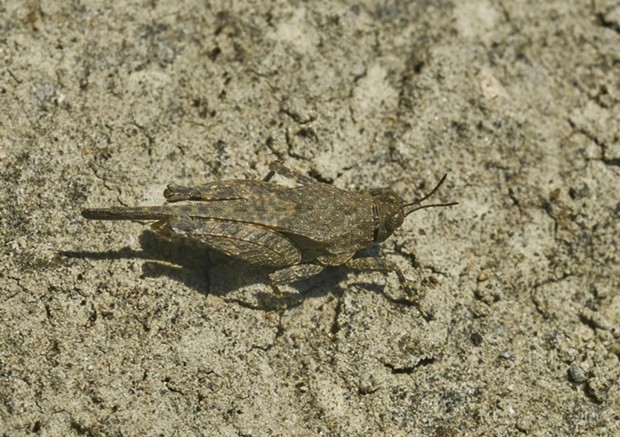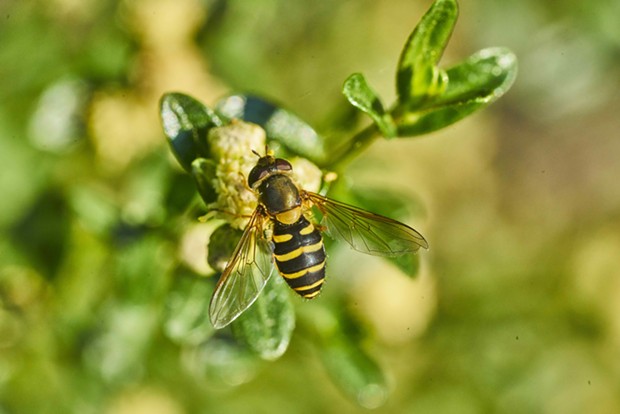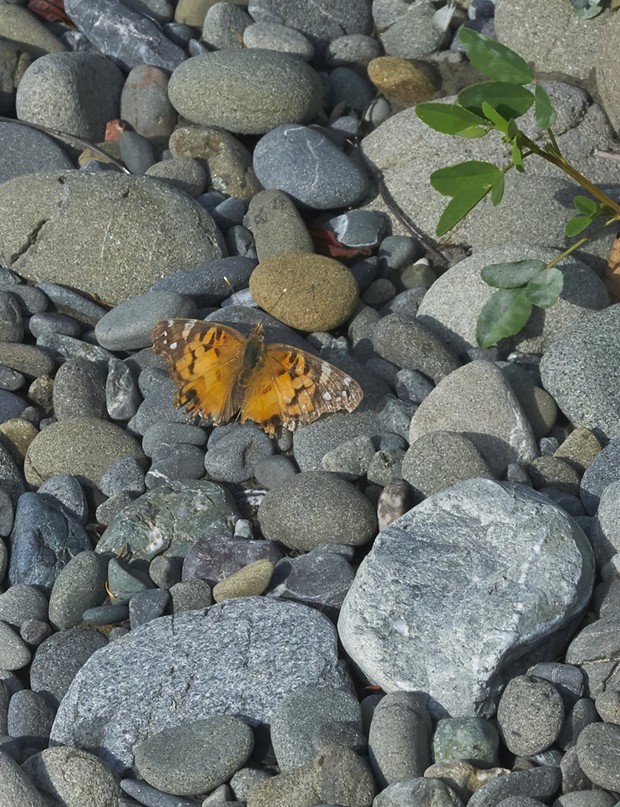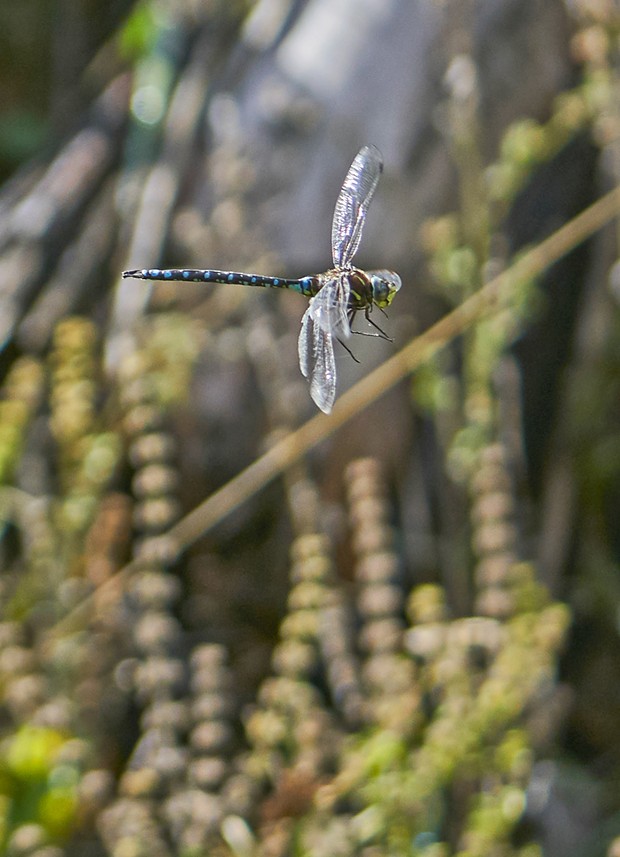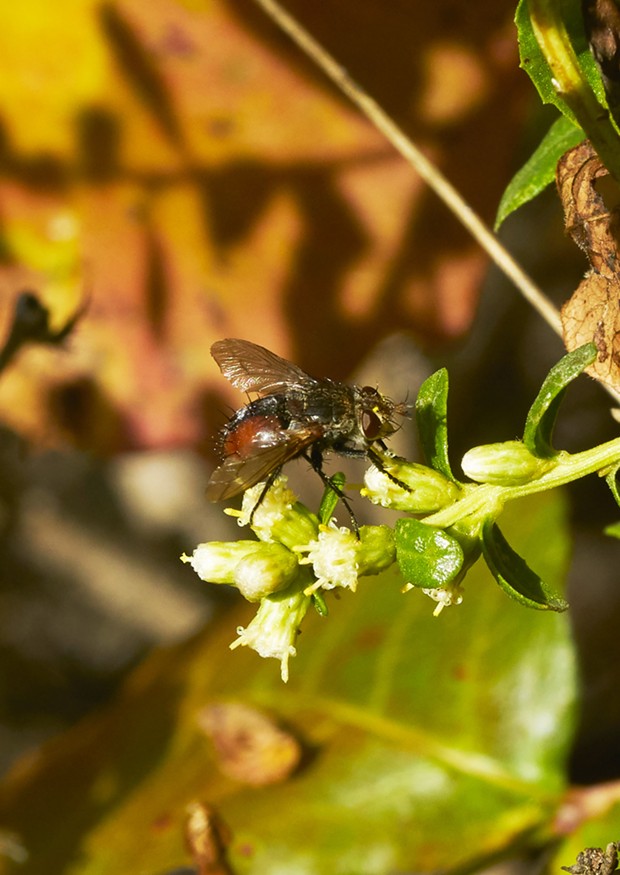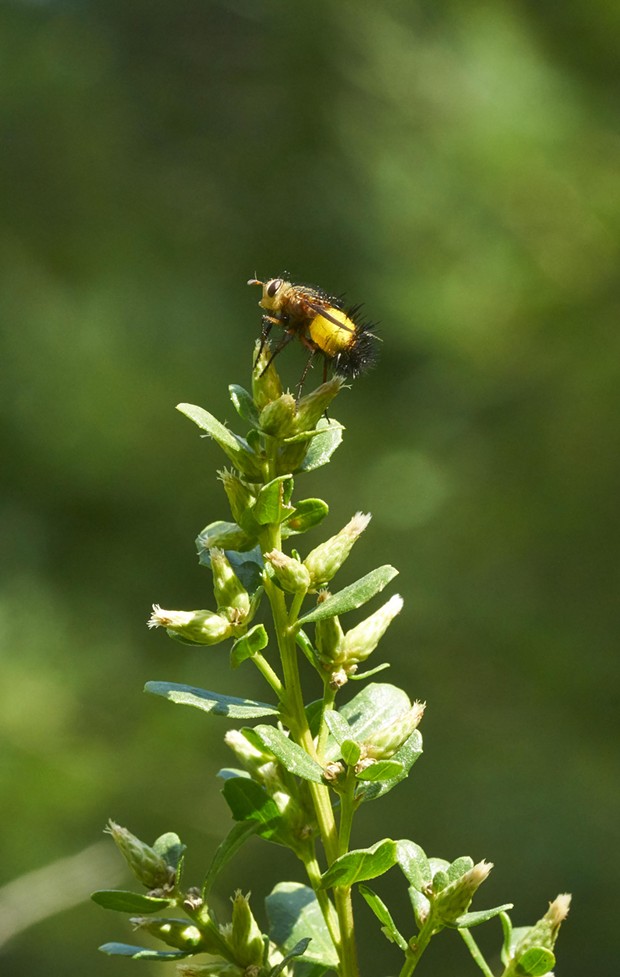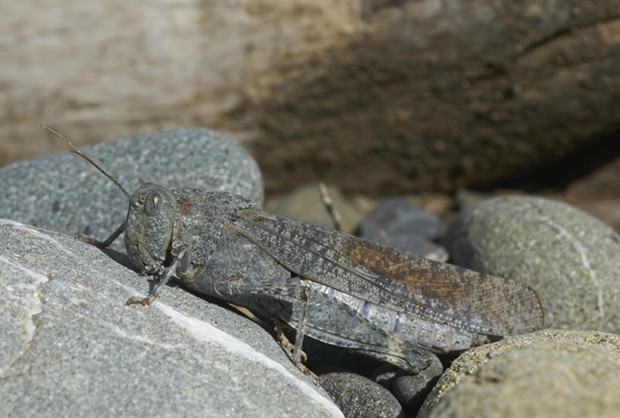Sunday, December 29, 2019
HumBug: Things that Need Bugs
Posted By Anthony Westkamper on Sun, Dec 29, 2019 at 10:50 AM
I didn't expect to see a lot of insects but it was sunny today so I went for a walk along “my” stretch of the Van Duzen River. I saw exactly two flies, a lone wolf spider and some flying things too tiny and far away to identify. I did see a couple of creatures that depend on insects for their survival, however.
One of the creepiest critters I know is the horsehair worm (Phylum nematomorpha). Parasites of grasshoppers and their kin, they're found writhing in ponds or other stagnate water. Very likely the one I saw developed inside a grasshopper, consuming it from the inside out. Once mature, it dominated its host's nervous system, causing it to seek water in which to drown itself, allowing the worm to escape into the puddle where I found it. I am glad to relate they are not a serious threat to humans or our livestock.
At the other end of the creepy/cute scale, I was delighted to see a ruby-crowned kinglet (Regulus calendula). These tiny, nervous songbirds are constantly on the move, scouring the brush for insects to eat. Recent studies have shown that songbird populations have dwindled throughout North America. Conversion of natural habitat to farmland and the use of neonicotinoid insecticides used to protect our crops appear to be contributors. Apparently it's us or them.
Of course, as soon as I got home and put down my camera, I noticed the sun glinting off the wings of a small dragonfly in my front yard. Although the glimpse was brief, I am certain it was a variegated meadowhawk, the only dragonfly I know of that endures the cold temperatures and survives our local winters.
One of the creepiest critters I know is the horsehair worm (Phylum nematomorpha). Parasites of grasshoppers and their kin, they're found writhing in ponds or other stagnate water. Very likely the one I saw developed inside a grasshopper, consuming it from the inside out. Once mature, it dominated its host's nervous system, causing it to seek water in which to drown itself, allowing the worm to escape into the puddle where I found it. I am glad to relate they are not a serious threat to humans or our livestock.
At the other end of the creepy/cute scale, I was delighted to see a ruby-crowned kinglet (Regulus calendula). These tiny, nervous songbirds are constantly on the move, scouring the brush for insects to eat. Recent studies have shown that songbird populations have dwindled throughout North America. Conversion of natural habitat to farmland and the use of neonicotinoid insecticides used to protect our crops appear to be contributors. Apparently it's us or them.
Of course, as soon as I got home and put down my camera, I noticed the sun glinting off the wings of a small dragonfly in my front yard. Although the glimpse was brief, I am certain it was a variegated meadowhawk, the only dragonfly I know of that endures the cold temperatures and survives our local winters.
Sunday, December 15, 2019
HumBug: Best of the Bugs
Posted By Anthony Westkamper on Sun, Dec 15, 2019 at 11:04 AM
After almost five years doing a weekly blog it had to happen. With rainy, cold weather and the fact that over the last several years I've already written about most of the noteworthy entomological subjects hereabouts, this week I didn't see any new critters worth photographing or writing about. So I think I'll do what other writers do in similar circumstances and resort to a “Best of” article, selecting a half dozen of my all time best photographs with an explanation of what makes them my personal favorites.
In 2009, driving across State Route 36 for work, I stopped at a wide spot near a small spring to stretch my legs. I got out my new digital camera and took a shot at a dragonfly perched on a stick. When I downloaded it onto my computer, I was amazed at how well it turned out. That one shot got me hooked.
In 2009, driving across State Route 36 for work, I stopped at a wide spot near a small spring to stretch my legs. I got out my new digital camera and took a shot at a dragonfly perched on a stick. When I downloaded it onto my computer, I was amazed at how well it turned out. That one shot got me hooked.
Sunday, December 8, 2019
HumBug: Preserved for Posterity
Posted By Anthony Westkamper on Sun, Dec 8, 2019 at 11:06 AM
I recently did something I haven't done in a long time. I went looking for glow worms in my backyard. Locally I've found them to be amazingly common in the leaf litter beneath our local redwoods but lately they had been absent from our usual haunts. This time though, I was greeted by at least half a dozen in my little area. (For a more detailed introduction to our local luminaries check out my previous post "Glow Worm vs. Snail," Dec. 11, 2016.)
Sunday, November 24, 2019
HumBug: Revisiting Old (Poisonous) Friends
Posted By Anthony Westkamper on Sun, Nov 24, 2019 at 4:27 PM
Back on Oct 2., 2016, I posted an article on the infestation of western black widow (Latrodactus hesperus) spiders at the Carlotta Post Office. Just this week my wife and I had occasion to visit the area again. Guess what?
As we strolled along the walkway directly in front of the post office, I nearly tripped over a large black spider. One look an I knew they were back. Adult widows are distinctive. Their backs are very black (juveniles sport white markings), as if they had been carved from a piece of obsidian. Their abdomens have a distinctive red or orange hourglass mark. This one was definitely not a false black widow, like those I wrote about on Nov. 3 this year but the real deal.
As we strolled along the walkway directly in front of the post office, I nearly tripped over a large black spider. One look an I knew they were back. Adult widows are distinctive. Their backs are very black (juveniles sport white markings), as if they had been carved from a piece of obsidian. Their abdomens have a distinctive red or orange hourglass mark. This one was definitely not a false black widow, like those I wrote about on Nov. 3 this year but the real deal.
Sunday, November 17, 2019
HumBug: Late Butterflies, Hornets and Moths
Posted By Anthony Westkamper on Sun, Nov 17, 2019 at 5:37 PM
A quick walk along the Van Duzen River turned up one each variegated meadowhawk and shadow darner dragonflies neither of which allowed me to get close enough to get a photo. It's OK, I have hundreds of shots of the meadowhawk and dozens of the shadow.
We got glimpses of a California sister butterfly, a cabbage butterfly, and an American rubyspot damselfly. They were all too active for pictures.
We got glimpses of a California sister butterfly, a cabbage butterfly, and an American rubyspot damselfly. They were all too active for pictures.
Sunday, November 10, 2019
HumBug: Spiders at School
Posted By Anthony Westkamper on Sun, Nov 10, 2019 at 3:51 PM
I recently did some walkabout lectures at a local middle school. The format was to walk around the campus for about 45 minutes and discourse on the various organisms we encountered. I did this six times with different groups. Aside from the stationary trees and plants, the organisms we encountered most reliably were the little wolf spiders (family lycosidae, most likely genus Padrosa).
Wherever you looked, they ran through the lawns in front of us. They were everywhere. In a cool off-season wandering we encountered hundreds. Starting life about the size of the head of a pin, if they're lucky, they capture enough prey to grow, shed their skins and grow again. Judging from sheer numbers, they must be one of the most successful lifeforms around and each full-sized individual must represent a dozen or so prey captured/killed.
Wherever you looked, they ran through the lawns in front of us. They were everywhere. In a cool off-season wandering we encountered hundreds. Starting life about the size of the head of a pin, if they're lucky, they capture enough prey to grow, shed their skins and grow again. Judging from sheer numbers, they must be one of the most successful lifeforms around and each full-sized individual must represent a dozen or so prey captured/killed.
Sunday, November 3, 2019
HumBug: An Innocent Imposter
Posted By Anthony Westkamper on Sun, Nov 3, 2019 at 11:19 AM
Being the local “Bug Guy” I was recently asked about a spider that looked “almost exactly like a black widow,” but lacked the distinctive red hourglass on the underside of its abdomen. This is a spider with which I am very familiar. They were nearly everywhere where I grew up in Pacifica, California. I hadn't seen any hereabouts but I was fairly confident what was being described was a female “false black widow” or Steatoda grossa. Although in the same family as the notorious mate-killer, this spider is much less dangerous and is usually timid. Neither are they the typical jet black of the widows, but usually a dark maroon.
Sunday, October 27, 2019
HumBug: Ashes and Dancers
Posted By Anthony Westkamper on Sun, Oct 27, 2019 at 1:30 PM
While I was doing a bit of outside work atop a ladder, several tiny chalk white dots flew with slow grace. They often appeared almost magically as they meandered through shafts of sunlight and then disappeared into the shadows. They were out of range of my cameras and I was too busy to investigate.
The following day, however, when I saw them again, I was armed with a good camera and had my feet firmly on the ground. I reached out and scooped one from the air. On the wing it looked more like a tiny bit of ash than a living thing, but in hand it turned out to be a “wooly aphid,” most likely of the subfamily Eriosomatinae. They grow tiny white filaments of waxy exudate. Many members of this group cause galls on herbaceous plants and can carry plant diseases.
A tad farther along, I saw a damselfly. On downloading the photos, I thought it might be an Emma's dancer, the only lavender insect I know off hand. But this specimen had blue patches on it and a few minor markings didn't quite match, so I posted it in a local Facebook group and got an authoritative ID from an expert. This was not Emma's, but a vivid dancer. In this case the word “vivid” is not just descriptive; it is actually its name (Argia vivida). Its unusual color may be from it having gotten cold.
I saw two grouse locusts, which resemble tiny grasshoppers to whom they are closely related. At about half an inch long, they can be found along stream banks where they eat algae from the rocks. Unlike their larger relatives, they can and do overwinter.
Finally, a flower fly caught my eye nectaring on a coyote bush. Mimicking a wasp's black and yellow warning coloration may give this inoffensive species some protection from predation.
The following day, however, when I saw them again, I was armed with a good camera and had my feet firmly on the ground. I reached out and scooped one from the air. On the wing it looked more like a tiny bit of ash than a living thing, but in hand it turned out to be a “wooly aphid,” most likely of the subfamily Eriosomatinae. They grow tiny white filaments of waxy exudate. Many members of this group cause galls on herbaceous plants and can carry plant diseases.
A tad farther along, I saw a damselfly. On downloading the photos, I thought it might be an Emma's dancer, the only lavender insect I know off hand. But this specimen had blue patches on it and a few minor markings didn't quite match, so I posted it in a local Facebook group and got an authoritative ID from an expert. This was not Emma's, but a vivid dancer. In this case the word “vivid” is not just descriptive; it is actually its name (Argia vivida). Its unusual color may be from it having gotten cold.
I saw two grouse locusts, which resemble tiny grasshoppers to whom they are closely related. At about half an inch long, they can be found along stream banks where they eat algae from the rocks. Unlike their larger relatives, they can and do overwinter.
Finally, a flower fly caught my eye nectaring on a coyote bush. Mimicking a wasp's black and yellow warning coloration may give this inoffensive species some protection from predation.
Sunday, October 20, 2019
HumBug: Late Bloomers Get All the Action
Posted By Anthony Westkamper on Sun, Oct 20, 2019 at 3:23 PM
Flowers being few and far between lately, nectar-sipping insects are also scarce. A few straggling rabbit brush plants concentrate relict butterflies, having completed their reproductive cycle living out their lives on instincts alone. I saw five species today, only two of which allowed me to get close enough to take their pictures. Tattered wing margins betray a long and adventurous life for the single American painted lady butterfly (Vanessa virginiensis) I saw.
I did see several acmon blues (Plebejus acmon). This tiny butterfly has multiple generations throughout the year. It seems the specimens get progressively smaller with each brood, starting out with wings as large as my thumbnail and decreasing to the size of my ring finger nail by this time of year.
Although the weather has been getting colder and wetter, there were at least two species of dragonfly out, variegated meadowhawks and shadow darners. Both notably late season species hereabouts.
One local native late blooming plant is coyote brush (Baccharis pilularis) which attracted quite a bit of activity from wasps and flies. Two tachnid flies stood out, one with an orange abdomen and the other with a bright yellow one (Xanthoepalpus bicolor).
These punk rock-looking, spiny parasitoid species lay eggs in or on the larva of other insects which their larvae consume alive from the inside out. They can play a significant role in controlling populations of their host species. Like wasps with a similar lifestyle, the adults feed on nectar.
I did see several acmon blues (Plebejus acmon). This tiny butterfly has multiple generations throughout the year. It seems the specimens get progressively smaller with each brood, starting out with wings as large as my thumbnail and decreasing to the size of my ring finger nail by this time of year.
Although the weather has been getting colder and wetter, there were at least two species of dragonfly out, variegated meadowhawks and shadow darners. Both notably late season species hereabouts.
One local native late blooming plant is coyote brush (Baccharis pilularis) which attracted quite a bit of activity from wasps and flies. Two tachnid flies stood out, one with an orange abdomen and the other with a bright yellow one (Xanthoepalpus bicolor).
These punk rock-looking, spiny parasitoid species lay eggs in or on the larva of other insects which their larvae consume alive from the inside out. They can play a significant role in controlling populations of their host species. Like wasps with a similar lifestyle, the adults feed on nectar.
Sunday, October 13, 2019
HumBug: Fall along the River
Posted By Anthony Westkamper on Sun, Oct 13, 2019 at 3:13 PM
There are next to no flowers blooming now. Most adult insects have lived out their lives, their eggs and larvae sequestered in anticipation of winter. The showiest life is along the river. The large body of moving water moderates the temperatures and many species employ this time of reduced predator numbers to complete their lifecycles unmolested.
Yesterday I did see a monarch butterfly, presumably migrating South toward Mexico. Their miraculous lifecycle having been disrupted in many ways so there is a movement to plant Milkweed in gardens and plots along their known migratory lanes. Theirs is a multi generational journey and their young depend on milkweed as food. Their bodies not only tolerate the plant toxins, but concentrate them in their tissues which makes them toxic to many predators.
Cryptically colored Carolina grasshoppers (Dissosteira carolina) are still with us. They leap forth and fly on white edged black wings, occasionally startling us as we walk along the river bar.
Yesterday I did see a monarch butterfly, presumably migrating South toward Mexico. Their miraculous lifecycle having been disrupted in many ways so there is a movement to plant Milkweed in gardens and plots along their known migratory lanes. Theirs is a multi generational journey and their young depend on milkweed as food. Their bodies not only tolerate the plant toxins, but concentrate them in their tissues which makes them toxic to many predators.
Cryptically colored Carolina grasshoppers (Dissosteira carolina) are still with us. They leap forth and fly on white edged black wings, occasionally startling us as we walk along the river bar.
